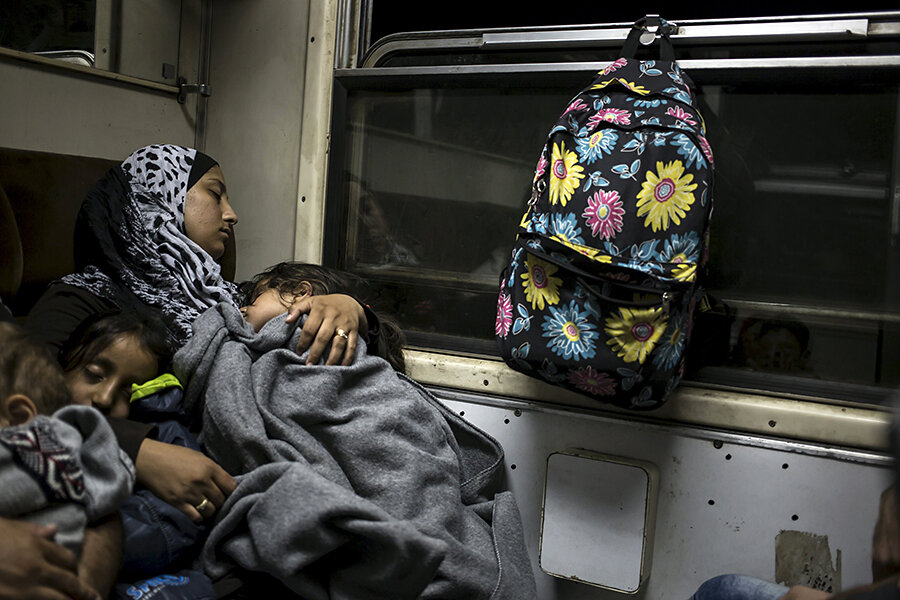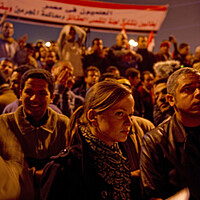More women and kids making the refugees' trek to Europe. Why now?
Loading...
| Belgrade, Serbia
Zahraa and Alaa al-Mansouri didn’t want to bring their three little girls on a dangerous journey to Europe. But they felt they had little choice. Their home in Baghdad was even more perilous.
Like hundreds of thousands of other refugees and migrants, they paid a smuggler to ride in a rubber boat from Turkey to the Greek islands. Halfway there, the boat capsized – tears fill Zahraa’s eyes as she recalls how fellow passengers held her youngest, a six-month-old baby, above the waves as they waited for rescue.
The difficulties continued after they made land, traveling until they reached this muddy park in Belgrade. But they never considered not making the trip together. “We can’t separate, my wife and I,” says Alaa.
Earlier this year, the travelers making their way to Europe on a land route through the Balkans were mainly young and middle-aged men who planned to bring their wives and children to Europe legally once they arrived and claimed asylum. But as the number of migrants rose dramatically through the summer, so did the number of women, children, and elderly. Now, everywhere along the route, parents carry their babies, walk with children in tow, and push the wheelchairs of their elders. Pregnant women have even given birth along the way.
Zahraa smiles at her husband. “I couldn’t consider sending him ahead alone,” she says. “I didn’t want to separate my children from their father, and family reunification takes so long.”
Difficult, but ultimately faster
A major factor behind the increase was the move by countries along the route to shift from blocking the flow of people to essentially facilitating their progress. That made the journey easier, and more possible to do with children.
That also meant less need for smugglers, making the trip cheaper, so families could afford to send more members.
Finally, as thousands of refugees and migrants arrived in destination countries like Germany and began the bureaucratic process of requesting asylum, they realized that family reunification – where the family of someone who is granted asylum is allowed to travel legally to join that person – takes much longer than they expected. They began advising others to bring their families with them.
Now, many families are stranded at the Hungarian border with little access to shelter, after Hungary closed its border with Serbia Tuesday, blocking the main route refugees take north.
For Saleh and Bayan, a young Syrian couple from Deir Ezzour, the decision to travel as a family came after Saleh’s brother arrived in Austria and realized it would take more than a year before his family would be able to join him.
The two, who didn’t want to give their last names, are traveling not only with their one-year-old son Mohamed, but also with Saleh’s brother’s 10-year-old son, planning to bring him to his father in Austria. They tell authorities he’s their son so he won’t be put in a camp for unaccompanied minors.
“We decided to go all together because it will be a difficult period, but then it will be over,” says Saleh. “The other way, it would take too long. And it’s too dangerous for my wife to stay in Syria, and too expensive for her to stay in Turkey.”
But they would not have been able to make the journey with the children had it not been for Macedonia’s change of law.
Easier than it was
In the first half of the year, the journey through the Balkans – by boat from Turkey to Greece, then overland through Macedonia, Serbia, and Hungary – was much more difficult.
Macedonian police stopped refugees on the border, turning them back to Greece, so many hiked through difficult terrain to cross the border at night, undetected. Migrants were not allowed to travel on buses or trains, so many either paid smugglers to drive them, or walked the entire length of the country – more than 100 miles – on foot.
In June, Macedonia passed a law allowing refugees to register with police and receive papers giving them 72 hours to transit the country by public transportation. Police now allow refugees to cross the border at a specific point, and put them on trains and buses after registering them. In Serbia, a similar system means they also have access to transport and some hotels.
But even so, it’s not easy. Bayan’s face is ragged with exhaustion. As she spoke, the baby asleep in her arms woke and began to cry.
“This is the problem,” says Saleh, as his wife discreetly began to breastfeed the child. They planned to try to cross into Hungary without being detected by police. “If he cries on the border, the police will find us, and we’re done.”








